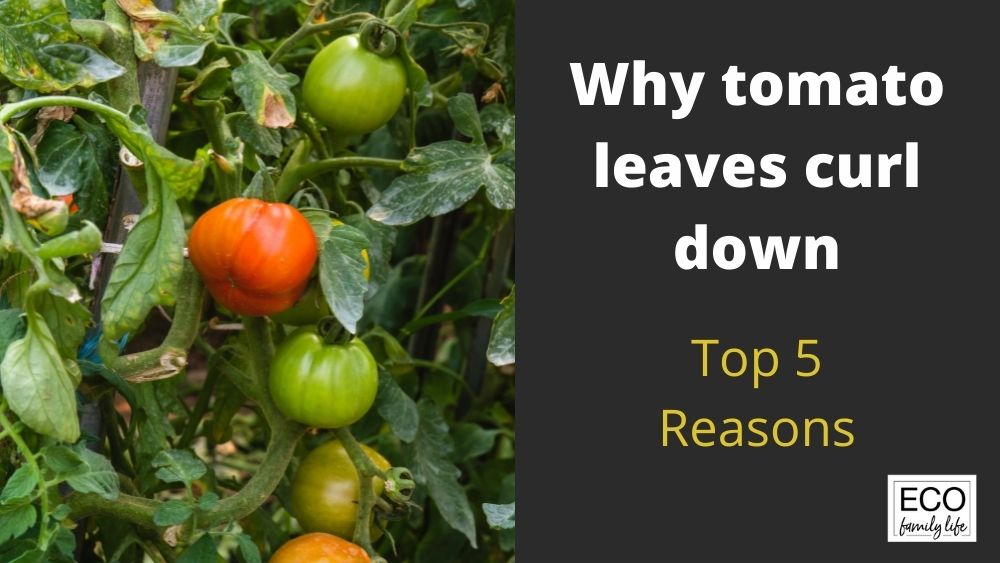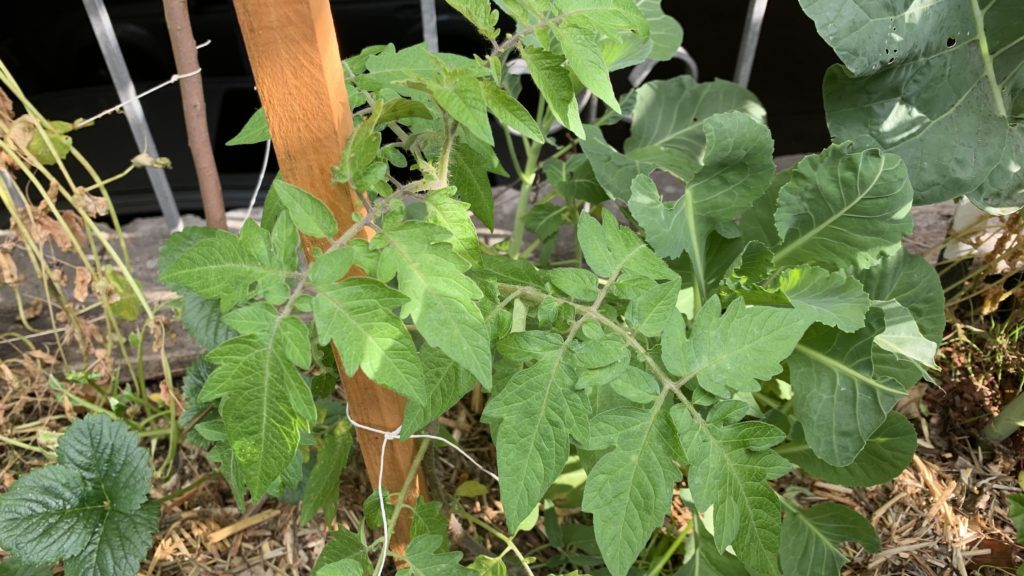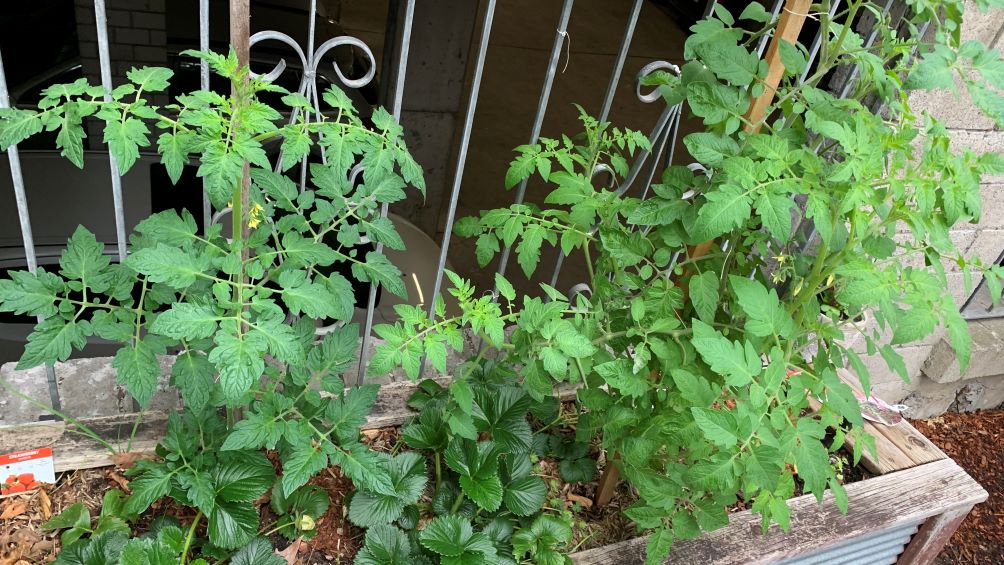Tomato leaves can curl down because of viruses, fungal infections, a lack of water, overwatering, fungal growth or pest infection. Working out why tomato leaves are curling is essential to address the issue. Regularly watering tomato plants, adding a thick layer of mulch and making sure the plants are adequately spaced apart is essential to prevent leaf curl.
Spacing tomato plants at least 2 feet apart will help to increase air movement which can prevent viruses, fungal infections and stop them spreading from plant to plant.

This article will explore the top reasons why tomato leaves curling down and what you can do to solve each one.
Top reasons why tomato leaves curl down
Here are the most common causes of tomato leaves curling down and how to solve each one.
1. Lack of water

The simplest cause of tomato leaves curling downwards is due to a lack of water. Tomatoes leaves will droop if the plant is not getting enough or regular water. Tomatoes can become water stressed quickly especially if the weather is warm.
During summer they can benefit from afternoon shade if you live in a very hot, dry region. This will slow down the rate at which water is lost from the soil and will stop the leaves from curling downwards.
To solve this problem, regularly water tomatoes at the start or end of the day. Cover the soil with 2-3 inches of mulch to stop the water evaporating quickly out of the soil. Before planting tomatoes, enrich the soil with compost and aged cow manure to help it to hold water for longer.
2. Too much water
Tomato plants that are getting too much water can develop leaves that curl downwards. Waterlogged soil can cause fungal root rot, which stops the plant from absorbing the moisture and nutrients it needs.
Damaged plants will start to suffer, developing leaves that curl down and this usually is followed by brown leaf tips and yellowing leaves. This is a sign of nutrient deficiency that can quickly kill the plant.
To help to solve this problem, top dress the tomatoes with 1-2 inches of aged cow manure or compost. Cover the soil with 2-3 inches of straw or bark mulch to absorb extra moisture. Feed the plant with a handful of pelted chicken manure.

Feed the plant with a dose of liquid fish fertilizer mixed with liquid seaweed to give it the best chance of recovery. Slow down your watering schedule to avoid overwatering.
3. Broad Mite
Broad mites are a tiny mite that live on the underside of tomato leaves. They suck the sap from the leaves causing them to curl downwards. The mites are tiny, less than 1mm so cannot be seen without a magnifying glass. You can see the eggs however which look like tiny, yellow dots.
Mites can get onto plants from other tomato plants brough into your yard or from other insects that carry the mite. The best thing to do if a tomato plant is affected by these mites is to remove the whole plant so the others don’t get infected.
Once the mite population gets out of control the plant will die quicky anyway so it is best to remove it before the problem spreads.
4. Viruses
There are hundreds of viruses that can affect tomato leaves causing them to curl inwards. They are often spotted by black, yellow or brown spots on the leaves. Here are a few common viruses that affect tomato plants and cause leaf curl.
Tomato Yellow Leaf Curl Virus
Common in Texas, this virus spreads to tomato plants via sweet potato plants or silverleaf whitefly (Bemisia tabaci). To control the virus it is best to manage the whitefly by spraying with a horticultural oil. This will smother and kill the whitefly stopping it from spreading the disease any further.
5. Not enough sun
Tomato plants that are not getting enough sunlight can grow leggy and their leaves can droop down. As the leaves grow larger they will not have the strength to hold their leaves up and straight. Tomatoes need at least 6 hours of sunlight to grow well.
Tomatoes that are growing in too much shade will grow long stems and long leaves which will bend down. To solve this problem gradually move the plants into more sun. As the summer comes the daylight hours will extend which will help tomatoes to grow strong leaves outdoors.
Why tomato leaves curl up
Tomato leaves can curl up but for different reasons to why they curl down. It is usually in response to hot weather and winds which cause the leaves to defensively curl in to reduce water loss. Check out the top reasons why tomato leaves curl up.
Wind damage
When warm winds arrive in summer, this can cause tomato leaves to curl. They will curl inwards as a way to protect themselves from further water loss. If this happens for a short period of time then the plant can recover quickly.
Wait until the end of the day and water the plant deeply. Provide shade to the plant if you can and the leaves will uncurl in the morning.
Will curled tomato leaves flatten out?
Curled tomato leaves can flatten out if the problem is caught early. Tomato leaves that are still green without yellowing or browning can recover fully. Feed the plant with a slow release organic fertilizer like pelleted chicken manure, add mulch and water the plant well. Avoid overwatering and your tomato plant can recover quickly.

Viruses can be more difficult for the plant to recover from. If you do notice that the problem is continuing it is best to remove the affected parts of the plant or the whole tomato plant. This can save the rest of your crop and reduce the chance that the infection will spread.
Why are my Tomato Leaves Curling Down? | Summary
Tomato plants can develop leaves that curl down if they are affected by viruses, pests or are not getting enough sunlight. Tomatoes can recover quickly if you give them the water, sunlight and nutrients they need. Viruses and pests can be trickier to address but horticultural oils or neem oils are a great start to get rid of sap sucking insects.
Happy growing.
I am an accredited practicing dietitian, experienced gardener and a dedicated cook. I love writing and sharing my experience so you can learn from my successes and mistakes.
